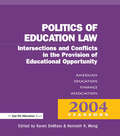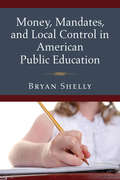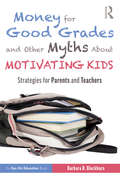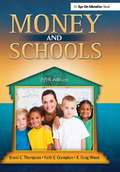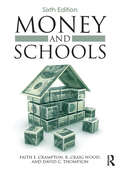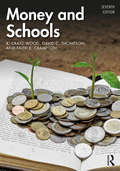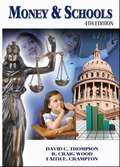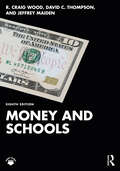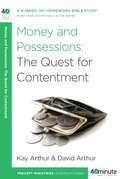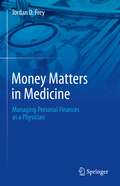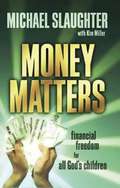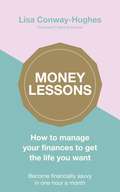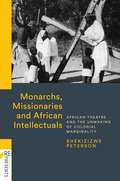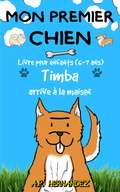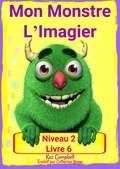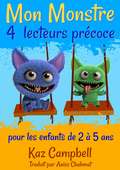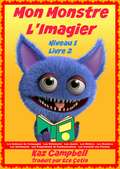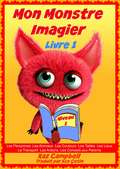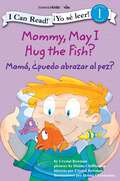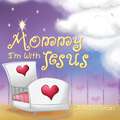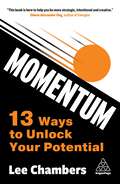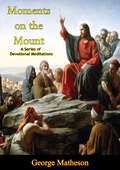- Table View
- List View
Monica Plum's Horrid Problem: A Story For Children Of Troubled Parents (Helping Children with Feelings)
by Margot Sunderland Nicky ArmstrongThis is a story for children with troubled parents. Monica has a horrid problem. It gets everywhere: into her schoolwork, her dreams, and her ability to make friends. People keep telling her to cheer up. She can't. She feels as if she is carrying around some very heavy luggage. Then one day, a helpful teacher sees how miserable Monica is, and tells her about the knights in the world, who are posing as people. In a whispering wood, Monica finds some of these knights. They teach her how to make her problem far less horrid. In particular they show her how to cope when other people's problems weigh you down and make you feel miserable. Most importantly they show her how to do life well. Monica leaves whispering wood feeling empowered and ready to face what she could not face before.
Money, Politics, and Law
by Kenneth K. Wong Karen DeMossThis yearbook offers research and insights to stimulate thought, inform debates, and explore future research directions.
Money, Mandates, and Local Control in American Public Education
by Bryan ShellyPointing to the disparities between wealthy and impoverished school districts in areas where revenue depends primarily upon local taxes, reformers repeatedly call for the centralization of school funding. Their proposals meet resistance from citizens, elected officials, and school administrators who fear the loss of local autonomy. Bryan Shelly finds, however, that local autonomy has already been compromised by federal and state governments, which exercise a tremendous amount of control over public education despite their small contribution to a school system's funding. This disproportionate relationship between funding and control allows state and federal officials to pass education policy yet excuses them from supplying adequate funding for new programs. The resulting unfunded and underfunded mandates and regulations, Shelly insists, are the true cause of the loss of community control over public education. Shelly outlines the effects of the most infamous of underfunded federal mandates, the No Child Left Behind Act of 2001 (NCLB), and explores why schools implemented it despite its unpopularity and out-of-pocket costs. Shelly's findings hold significant implications for school finance reform, NCLB, and the future of intergovernmental relations.
Money for Good Grades and Other Myths About Motivating Kids: Strategies for Parents and Teachers
by Barbara R. BlackburnIn this helpful resource, expert educator Barbara R. Blackburn guides parents through the top eight myths about motivation and reveals what really works for kids. Each chapter is filled with practical information and stories that help you understand how to handle a variety of situations related to your child’s success at school. Blackburn helps you get to the bottom of issues such as: • Is motivating with rewards effective? • What if your student doesn’t care about school? • How does your relationship with your student affect their motivation? • How can you set high expectations without too much pressure? • Is it okay for my kid to struggle, get stuck, and fail? • How does competition affect success in school? • What should you do when nothing seems to be working? Chapters also include specific classroom connections for each strategy, so you can begin proactively working with your child's teacher. With the accessible advice in this book, you’ll be able to reach your child more effectively so that he or she is more motivated from within, and more successful in school and beyond! Bonus: Guides for collaboration between parents and schools are available on our website at www.routledge.com/9781138368200 so that schools can use the book to work more effectively with parents through PTA and PTO organizations, family support groups, and more. You'll also find a guide for parents to use to facilitate book clubs or reading groups.
Money and Schools: A Handbook For Practitioners (The\leadership And Management Ser.)
by Faith Crampton R Wood Craig David C ThompsonIn the new edition of this essential, all-inclusive text, the authors provide more important research for future principals and others enrolled in graduate-level school finance courses. Written in a style that is highly readable, the book offers strong connections to real-world experiences. Readers get both a broad overview of funding concepts and a detailed examination of daily funding operations and will come away with a deep understanding of the relationship between money and student achievement. New to this edition:Current research on the impact of money on student learning outcomes, New concepts that are gaining traction, such as sustainability, Current web resources and recommended reading
Money and Schools: A Handbook For Practitioners (The\leadership And Management Ser.)
by David C. Thompson Faith E. Crampton R. Craig WoodFor both aspiring and experienced education leaders in school budgeting, finance, and resource management courses, Money and Schools explains and demonstrates the relationship between money and equality of educational opportunity. Grounded in research and best practices, this book provides a broad overview of school finance, budgeting, and resource allocation, as well as a detailed examination of day-to-day funding operations. This accessible and engaging book offers strong connections to real-world experiences and detailed information on pre-K-12 funding history, concepts, and current operations. New to this edition:* Cutting edge research on the relationship of money and student learning outcomes, alterations to state aid distribution formulas, new federal education initiatives, and a changing landscape in school finance litigation.* New concepts that have gained traction since the last edition of the book, including school choice and privatization, Common Core State Standards, value-added teacher evaluation, and growth of online options at the K-12 level.* Updated end-of-chapter activities and additional resources that are aligned with the key concepts and content of each chapter.
Money and Schools: A Handbook For Practitioners (The\leadership And Management Ser.)
by David C. Thompson Faith E. Crampton R. Craig WoodFor both aspiring and experienced education leaders in school budgeting, finance, and resource management courses, Money and Schools explains and demonstrates the relationship between money and equality of educational opportunity in a way that is clear, precise, and engaging. Grounded in research and best practices, this book provides a broad overview of school finance, budgeting, and resource allocation, an understanding of the underlying economic, social, legal, and political principles that drive how schools are funded, as well as a detailed examination of day-to-day funding operations. Rich pedagogical features include chapter opening challenges, chapter drivers, point/counterpoint discussions, case studies, and recommended resources. This accessible and engaging book offers strong connections to real-world experiences and detailed information on pre-K–12 funding history, concepts, and current operations. New to this edition: Coverage of environmental sustainability and other emerging trends in this unprecedented uncertainty of schools' economic and social environment. Updates to references and overall funding changes since the previous edition. Revised end-of-chapter activities and additional resources that are aligned with the key concepts and content of each chapter. Updated supplemental downloads, including editable PowerPoints.
Money and Schools (4th Edition)
by David C. Thompson Faith E. Crampton R. Craig WoodFor future principals and others enrolled in courses on School Finance, this book explains and demonstrates the relationship between money and student achievement. New to this edition - Includes updated information on the ever-changing landscape of school finance. - Co-author Faith E. Crampton has joined the author team, applying the expertise she has acquired in public education, state government, national education and legislative organizations, and universities. - Chapters now include a section titled "Point - Counterpoint", offering opposing views on issues involving money and schools along with incisive questions to help guide classroom debates and/or individual analysis. - Case studies throughout the text provide opportunities to apply the knowledge gained in each chapter. - Also includes web sites and extensive recommended bibliography.
Money and Schools
by David C. Thompson R. Craig Wood Jeffrey A. MaidenMoney and Schools explains and demonstrates the relationship between money and equality of educational opportunity in a way that is clear, precise, and engaging. Grounded in research and best practices, this book provides a broad overview of school finance, budgeting, and resource allocation, an understanding of the underlying economic, social, legal, and political principles that drive how schools are funded, as well as a detailed examination of day-to-day funding operations. Rich pedagogical features include chapter drivers, point/counterpoint discussions, case studies, portfolio exercises, and web and recommended resources. This accessible and engaging book offers strong connections to real-world experiences and detailed information on preK–12 funding history, concepts, and current operations for both aspiring and experienced education leaders in school budgeting, finance, and resource management courses. New to this edition: Coverage of new concepts and trends, such as the political economy and culture of public education. Inclusion of cutting-edge research on the impacts of money on student learning outcomes. Expanded chapter-by-chapter annotations and recommended resources that point readers to other resources and explain key concepts in greater detail. New online supplemental downloads, including updated PowerPoints for Instructors and chapter-based interactive figures for download.
Money and Possessions: The Quest for Contentment (40-Minute Bible Studies)
by Kay Arthur David ArthurIn these days of economic uncertainty, and in a society that values financial security, money is an emotional topic. Appearances and lifestyle matter to us. And money-or the lack of it-often determines whether or not were content. The truth is, our attitudes toward money and possessions reflect the quality of our relationship with God. And, according to the Scriptures, our view of money reveals where our true affections lie. Prosperity is not a sin, but it does bring responsibilities. And scarcity is not a virtue, particularly when it distracts us from the things that truly matter. In this six-week study you will discover God's view of material wealth. As you dig into the Scriptures, you'll learn where money comes from, you'll see how we're supposed to handle it, and you'll understand how to live an abundant life, regardless of your financial circumstances.From the Trade Paperback edition.
Money Matters in Medicine: Managing Personal Finances as a Physician
by Jordan D. FreyThis book addresses both the philosophical and more tangible actionable components of attaining financial well-being as a medical professional. In an engaging, narrative-driven format, it relays the importance of managing one’s finances—even with the high salary of a doctor. Money Matters in Medicine is an accessible, invaluable resource for early-career physicians who wish to incorporate intelligent money management skills in their development as medical professionals. Chapters include information on becoming financially literate, how to approach insurance, creating a savings rate, and the top mistakes most doctors make with their money. Though there are many financial self-help books in the market, this book stands out, as it rests on philosophies and core standards held by those in the medical community. It presents the strategies to promote financial well-being and ultimately help doctors become more effective physicians with financial freedom. The book includes easy-to-understand guidelines and intuitive steps for readers to take massive action in their lives to improve their financial well-being.
Money Matters Participant's Guide: Financial Freedom for All God's Children
by Mike Slaughter Kim MillerA complete stewardship kit to prepare your congregation for generosity.Outline (7 sessions): 1. The Celebration of Creation2. The Freedom of Simplicity3. The Life of Generosity4. The Trust of Rightful Ownership5. The Joy of Faithful Stewardship6. The Faith in Promised Provision7. The Commitment to Ultimate SacrificeTarget audience: Participants guide: small groups in congregation; with at least the trustees and the church board.
Money Lessons: How to manage your finances to get the life you want
by Lisa Conway-HughesIf you spent one hour a month nurturing your finances for the next twelve months, how would you feel this time next year, what would be different? Mapping out a plan for achieving your big goals and managing everyday spending, Money Lessons is your own pocket financial expert. Whether you have it or not, money is often as difficult to talk about as it is to handle. Many of us will at one point need advice on how to:- ask for a pay rise- save up to buy a place- pay for a mortgage- finance a career move- budget for a wedding- fund a big trip- get out of debt- retire comfortablyBuilding on her 15 years of experience helping countless people to make smart financial decisions, Lisa Conway-Hughes tackles these topics in a short guide to being savvy and getting what you want in every stage of your life. Full of expert knowledge and success stories, this is essential reading for anyone who wants to turn a dream into a plan - and eventually a reality.
Money
by Guido Galeano Vega Maria Esther Wolburg DomínguezMoney by Guido Galeano Vega Money is something that we love, because we all need it, but it is a double-edged tool; it can brighten your life or it can destroy you. Money has an origin, it has a history, and it has evolved; not only in its purchasing power, but also in its versatility and agility of movement; it has evolved along with consumerism, and forms an essential part of it. All the social acceleration, the complexity of the economy, and the advanced technology are directly related to money. The great modern problems of some violent societies, many of the daily problems of the streets of the most complex cities, many of the worst legal transgressions, and many of the worst vices, have to do with money.
Monarchs, Missionaries and African Intellectuals: African Theatre and the Unmaking of Colonial Marginality
by Bhekizizwe PetersonMuch of the work in the field of African studies still relies on rigid distinctions of ‘tradition’ and ‘modernity’, ‘collaboration’ and ‘resistance’, ‘indigenous’ and ‘foreign’. This book moves well beyond these frameworks to probe the complex entanglements of different intellectual traditions in the South African context, by examining two case studies. The case studies constitute the core around which is woven this intriguing story of the development of black theatre in South Africa in the early years of the century. It also highlights the dialogue between African and African-American intellectuals, and the intellectual formation of the early African elite in relation to colonial authority and how each affected the other in complicated ways.The first case study centres on Mariannhill Mission in KwaZulu-Natal. Here the evangelical and pedagogical drama pioneered by the Rev Bernard Huss, is considered alongside the work of one of the mission’s most eminent alumni, the poet and scholar, B.W. Vilakazi. The second moves to Johannesburg and gives a detailed insight into the working of the Bantu Dramatic Society and the drama of H.I.E. Dhlomo in relation to the British Drama League and other white liberal cultural activities.
Mon mystérieux Rêve
by Katrina Kahler Hanène BaatoutJournal intime destiné aux jeunes filles de 9 à 12 ans développant les thèmes de l’amitié, l’intimidation et les manières de se défendre. Julia est rongée par le doute. Aura-t-elle, un jour, la chance de posséder toutes ces choses merveilleuses que ses amis obtiennent si facilement? Sans oublier de parler du garçon le plus mignon de la classe, avec lequel elle aimerait sortir et auquel elle ne cesse de penser ? Apparemment, rien ne va ... ça, s'était jusqu'au moment où elle découvre un livre exceptionnel qui l'aide à croire que son mystérieux rêve pourrait se réaliser, après tout. L'intrigue de "Mon mystérieux Rêve" est captivante. Tu vas en être imprégnée dès le premier chapitre et tu te demanderas, à chaque instant, ce qui va se passer par la suite. Quel est le rêve mystérieux de Julia ? Deviendra-t-il réalité, un jour ? Une histoire à couper le souffle qui inspirera, à coup sûr, toutes nos jeunes lectrices !
Mon Premier Chien: Livre pour enfants (6-7 ans) - Timba arrive à la maison
by A. P. HernándezSynopsis: Sophie a sept ans et elle veut un chien. Elle le veut pour jouer à prendre le thé, pour le brosser et pour chevaucher sur son dos comme une vraie cavalière. Sophie veut le chien et elle le veut maintenant. C’est que presque tous ses amis de l’école ont un animal de compagnie, à part elle. C’est pour cela, et après avoir beaucoup insisté, qu’elle réussit à convaincre ses parents de la laisser avoir un chien. Et donc, une bonne journée… Timba arrive à la maison ! Mais Timba n’est pas prêt à jouer avec Sophie. Timba n’aime pas prendre le thé, il n’aime pas qu’on le brosse, et encore moins, il veut que personne monte sur son dos. Sophie comprend donc que Timba n’est pas un jouet et qu’il sera essentiel de gagner sa confiance et son affection. Un livre pour enfants recommandé pour les jeunes à partir de 6-7 ans. Avec ce livre pour enfants, les plus petits comprendront qu’adopter un chien implique une grande responsabilité. Grâce aux aventures de Sophie, nous sommes amenés à réfléchir sur le temps nécessaire dont un chien a besoin, l’importance de l’emmener chez le vétérinaire, la nécessité de le promener tous les jours et de faire de l’exercice avec lui tout comme de l’éduquer. “Mon premier chien” est un livre de premier cycle adapté pour être lu à haute voix aux plus petits. De même, cela permettra aux garçons et aux filles d’entreprendre leur aventure dans le monde de la lecture par eux-mêmes.
Mon Monstre L’Imagier – Niveau 2 Livre 6
by Kaz Campbell Catherine VenneApprendre à livre L’Imagier Niveau 2 Livre 6 pour lecteurs débutants. Le livre 6 porte sur les nombres de 1 à 20 et sur comment compter. On y revoit les mots couverts dans les livres 1, 2 et 3 de Mon Monstre Niveau 1dans des phrases courtes et simples. Chaque page est accompagnée d’une image pour faciliter la lecture pour les enfants. Les concepts importants comme la valeur des nombres et diviser les nombres en 10 et # sont couverts dans le livre 6. Cette série vous permettra d’enseigner à votre enfant à lire et de leur donner un bon coup de pouce dans leur apprentissage. Il y a 6 livres L’imagier dans ce programme d’apprentissage à la lecture. Le Niveau 1 (mots simples et images) et le Niveau 2 (faire des phrases simples avec les mots imagés) comportent chacun trois livres. Les livres de la série Apprendre à lire sont tous numérotés, vous devriez les faire en ordre. Les livres Niveau 3 travaillent plutôt les sons de l’alphabet, la phonétique et les mots de même famille. Les livres Niveau 4 sont un peu plus avancés et sont destinés aux enfants qui ont déjà une petite base en lecture. S’ils ont déjà lu les neuf premiers livres de la série Mon Monstre, ils devraient être prêts pour le Niveau 4 Nouveaux lecteurs. Les livres Niveau 5 présentent de courtes histoires drôles à propos de gentils monstres qui amuseront votre enfant. Vous pouvez aussi lire ces livres aux enfants de 4 ans et plus. La série Mon Monstre Apprendre à lire est le moyen idéal pour enseigner la lecture à votre enfant. Ce livre comprend aussi un certain nombre de conseils sur l’apprentissage de la lecture pour vous aider.
Mon Monstre 4 - lecteurs précoce - pour les enfants de 2 à 5 ans
by Kaz Campbell Aniss ChahmatDescription du livre: Mon monstre pour les lecteurs précoces comprend des histoires faciles à lire pour les lecteurs débutants âgés de 2 à 5 ans. Suivez les aventures des monstres le premier jour à la maternelle; Au parc; Bonbons Ou Farce et aussi lire sur la fête d'anniversaire de monstre. Toutes les histoires ont des images pour aider la compréhension et le plaisir de la lecture de votre enfant. Il y a 2 sections bonus: des blagues de monstres, des devinettes et des vire langues ainsi qu'une section expliquant comment lire avec un jeune enfant. Kaz Campbell est une enseignante très expérimentée de la petite enfance. Ces histoires sont conçues pour aider votre enfant à apprendre à lire. Texte répété, phrases simples et texte prédictif dans toutes les histoires. Les personnages populaires de mon monstre et leurs images sont présentés dans les 4 histoires
Mon Monstre - L'Imagier - Niveau 1 Livre 2
by Kaz Campbell Ece ÇetinUn Livre d'Apprendre A Lire L'Imagier plein d'illustrations pour rendre l'Apprentissage A Lire plus facile pour les enfants de 2 à 5 ans Apprendre A Lire l’Imagier Livre 2 pour les Lecteurs Débutants. Le Livre 2 a plus de 100 pages avec des images colorées et intéressantes des Animaux de Compagnie, des Vêtements, des Jouets, des Métiers, des Nombres, des Sentiments et des Prépositions de Positionnement et leurs mots correspondants. Ce livre est le 2ème dans la série de Mon Monstre Apprend A Lire. Travaillez avec cette série de livres et vous serez capable d'apprendre à votre enfant à lire et leur donner un début de tête massive. Il y a 3 livres de l'Imagier dans le Niveau 1 (mots simples et des images) et chaque livre couvre 7 domaines différents. Les livres dans la série Apprendre A Lire sont tous numérotés, alors commencez avec Livre 1 et continuez à travailler avec les autres. Les livres de Niveau 2 (il y a aussi trois livres dans ce niveau) contiennent également les mots de l’Imagier, mais au lieu de mots simples, ils sont combinés en phrases courtes et simples. Une image accompagne chaque phrase... en rendant plus facile pour votre enfant à lire.
Mon Monstre - Imagier - Niveau 1 Livre 1
by Kaz Campbell Ece ÇetinLivre d'Apprendre A Lire Imagier plein d'illustrations pour rendre l'Apprentissage A Lire plus facile pour les enfants de 2 à 5 ans Apprendre A Lire Imagier Livre pour les Lecteurs Débutants. Dans le Livre 1 il y a plus de 100 pages avec des images colorées et intéressantes des Personnes, des Animaux, des Couleurs, des Tailles, des Lieux, de Transport et des Actions et leurs mots correspondants. Ce livre est le 1er Livre dans la série de Mon Monstre Apprend A Lire. Travaillez avec cette série de livres et vous serez capable d'apprendre à votre enfant à lire et leur donner un début de tête massive. Il y a 3 livres de l'Imagier dans le Niveau 1 (mots simples et des images) et chaque livre couvre 7 domaines différents. Les livres dans la série Apprendre A Lire sont tous numérotés, alors commencez avec Livre 1 et continuez à travailler avec les autres. Les livres de Niveau 2 (il y a aussi trois livres dans ce niveau) contiennent également les mots de l’Imagier, mais au lieu de mots simples, ils sont combinés en phrases courtes et simples. Une image accompagne chaque phrase... en rendant plus facile pour votre enfant à lire. L a série de Mon Monstre Apprend A Lire est la voie parfaite pour enseigner votre enfant à lire. Ce livre a également un certain nombre de conseils aux parents pour l’enseignement de la lecture afin d’aider vous et votre enfant.
Mommy, May I Hug the Fish? / Mamá: Biblical Values (I Can Read! #Level 1)
by Crystal BowmanPreschoolers want to explore their world but are not fully aware of harmful situations. When a loving parent or care-giver sets limits or gives permission, the child learns to respect his or her environment. Mommy, May I Hug the Fish addresses this subject in a humorous and age-appropriate way. The text is written in lively rhythm and rhyme and is designed for beginning readers. Los preescolares quieren explorar su mundo, pero no se dan cuenta por completo de las situaciones peligrosas. Cuando un padre, una madre o un cuidador cariñoso establece límites o da permiso, el niño aprende a respetar su medio ambiente. Mamá: ¿puedo abrazar al pez? trata de este tema de una manera divertida y apropiada para la edad. El texto ha sido escrito en un ritmo vivo y está diseñado para lectores principiantes.
Mommy, I'm with Jesus
by Claudia DuranExperiencing death and loss of an unborn baby is something we are all going to have to face at one point in our lives. There is no escape from it. Having a miscarriage isn’t shy of experiencing a loss of a life, a loved one. Despite the baby never being held or having a personality, it is still a loss. First time expectant parents experience this in a profound manner by a broken heart as if the heart is being wrung in a ringer. The desire to comfort their partner is frozen because the pain is so deep and they are also crying, unable to move as if they are so terrified they can’t make any sense of anything. This can be a very difficult time for some people especially if they have had multiple miscarriages and don’t get the compassion quiet as much as when a baby is born then passes away. <P><P>Nevertheless, it is still a loss, a death that the family experiences. In the book, Mommy I am with Jesus, this is a testimony and a journey that Claudia Duran has experienced. During the initial awareness of pregnancy and feeling the excitement and the unknown is such a blessing that a baby is being formed in the mother’s womb. Parents that have had the opportunity to see or hear their baby’s heartbeat in the mother’s womb brings love, joy and understanding of the life being formed. The parents feel a sense of a deep connection to the baby and to each other. The anticipation that comes with pregnancy, yet one day, and for no apparent reason, the baby’s heartbeat suddenly stops and there is nothing that can be done about it. It is hard to believe that a heart that was once alive and beating is no more. <P>There is no sound where there was once a racing heartbeat. Then flooding questions like where does the baby go? How does anyone get through the pain of losing a life, especially one that is unforeseen and hoped for? As stated in the bible, “If it were not so, would I have told you that I go to prepare a place for you?” John 14:2 offers hope that we will be reunited once more with those we have lost. In the movie, Heaven is for Real by Randall Wallace, there is a scene where the little boy who was said to have gone to heaven then came back told his mom that he had another sister and asked why she hadn’t told him. The mom broke down crying and told her little boy they had lost a baby and didn’t know the gender which gives hope for our unborn babies. Scenes like this hit home and puts a lump in your throat.This is a silent suffering and it doesn’t discriminate regardless of age, race or cultural boundaries. The ages and races of the women who lost their unborn babies range from 20-year olds to 40 somethings. There are so many people that have experienced this but never talked, mourned, and possibly healed from the loss of their unborn babies. Many times, expectant parents want to be alone, but what happens in that alone time? Do they have someone that can comfort them in a positive manner? The intention of this book is to comfort those who have lost an unborn baby. It is written in a simplistic manner as a means for healing the wounded heart within. It is also a basic aim for families to share with one another as well as to explain to small children and give them a basic understanding of the loss, as it can be overwhelming. As the book draws from bible verses that point to how babies are formed to where we go when we die it is a simple, yet profound style.
Momentum: 13 Ways to Unlock Your Potential
by Lee ChambersFor many of us, our lives have become over-complicated, defined by burnout and fatigue. This affects everything we do, from our home life to our work. We stop moving forward and we lose direction.But there is an alternative: build your Momentum and rediscover the joys of fulfilling your potential. Leading psychologist and wellbeing expert, Lee Chambers found success by prioritizing wellbeing and embracing uncertainty. In this book, he shares his thirteen essential tools to help you unlock your potential. From having a flexible vision and identifying how failure can move us forward, through to loving life's squiggles and working with empathy, you'll learn how to redefine success, wake up feeling excited about what you do and find your purpose.Momentum will keep you moving and is guaranteed to help you enjoy the ride.
Moments on the Mount: A Series of Devotional Meditations
by George MathesonTHERE are two motives which have influenced us in the production of this little book. We have sought, on the one hand, to supply aids to devotion either for the use of the family or of the individual, and on the other, to furnish points of suggestion to the student who is a prospective preacher. Perhaps it may be thought that these two aims are incongruous, and it would be too much to hope that in both we have succeeded; yet devotion is not the absence of thought, and thought is not necessarily the absence of devotion. At all events, the presence in the mind of two so reactionary aims may have had the beneficial result of preserving these meditations either from the fault of too much abstractness or from the sin of too little depth.IT is only in the cool of the day that I can hear Thy footsteps, O my God. Thou art ever walking in the garden. Thy presence is abroad everywhere and always; but it is not everywhere nor always that I can hear Thee passing by. The burden and heat of the day are too strong for me. The struggles of life excite me, the ambitions of life perturb me, the glitter of life dazzles me; it is all thunder and earthquake and fire. But when I myself am still I catch Thy still small voice, and then I know that Thou art God. Thy peace can only speak to my peacefulness, Thy rest can only be audible to my calm; the harmony of Thy tread cannot be heard by the discord of my soul. Therefore, betimes I would be alone with Thee, away from the heat and the battle. I would feel the cool breath of Thy Spirit, that I may be refreshed once more for the strife. I would be fanned by the breezes of heaven, that I may resume the dusty road and the dolorous way. Not to avoid them do I come to Thee, but that I may be able more perfectly to bear them. Let me hear Thy voice in the garden in the cool of the day.

